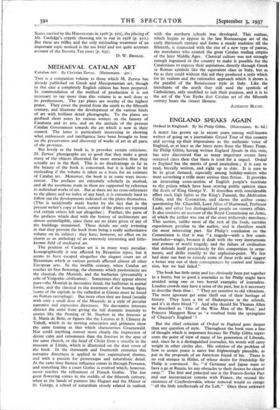PAST AND PRESENT OF U.S.A.
The Making of American Civilisation. By Charles A. Beard and Mary R. Beard. (Macmillan. 12s. 6d.)
Tins book is published at a time when the question of the study of American history, in Britain is being discussed and, as it is an excellent textbook, it can be warmly welcomed. Designed for American high schools, it is written seriously and soberly and no adult need be afraid that he will find this book in either plan or achievement beneath him. The school character of the main audience, it is true, is, at times, reflected in omissions. It may be surmised that in a book designed for an adult audience, the new realism of contemporary southern literature would not have been exclusively illustrated from Gone With the Wind ; however it would be unreasonable to expect a book of this kind to send its juvenile readers to Messrs. Caldwell, Stribling and Wolfe. The literary judgements are in general rather flat and conventional. It is surely a return to the much derided colonial attitude to quote an unnamed " severe English critic " to the effect that there " were few pieces in the works of even the very first of our living poets ' that exceeded Bryant's ode to death for sublimity and compass of poetical thought." Until we know the name of the critic we cannot decide whether Bryant is being ranked with Shelley and Wordsworth, or with Montgomery and Tupper, for Bryant was a contemporary of all four. And it is not easy to see why one should be left to guess that the cartoonist referred to on p. 873 is Fitzpatrick, the American equivalent of Low.
As we have learned to expect in a book from the hands of the Beards, the economic and social history of the nation is especially well done, but they never fall into the new romantic error of assuming that war and politics are unimportant because not all important. But it is worth noting that the illustrations which display such features of modern society as bridges, skyscrapers, slums, dams and canals are from photographs, while " mere history " tends to be given nice coloured pictures. One is entitled to expect a little more from the country that produced Brady two generations ago. And the numerous useful maps have only one defect, they are weak on the side of physical geography. In general, the judgements and narratives are miracles of objectivity, though the numerous admirers of Stephen Douglas may demur to the rather old-fashioned Republican view of the " Little Giant " and others may object to the too uniformly eulogistic picture of Lincoln. After all, if Lincoln is to get the credit for appointing Meade to replace Hooker he should suffer the discredit of having replaced McClellan by Burnside. Starting with the beginnings of modern exploration and going down to President Roosevelt's attack on the Supreme Court, this book is excellent value for the money. There are a few errors : Heiny Esmond for The Virginians (p. 117), the implication that Grant was not politically from Illinois (p. 6;t), the failure to list Florida among the States carried by the Hoovercrats it:1.1928 (p. jig), the placing of Mr. Coolidge's cryptic choosing not to run 111 1928 (p. 910.) But these are trifles and the only misleading treatment of an important topic noticed is the too brief and not quite accurate account of the Income Tax cases (p. 635).
D. W. BROGAN.











































 Previous page
Previous page